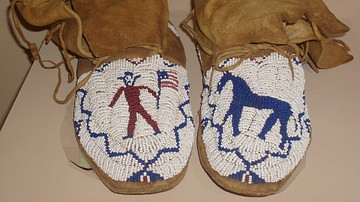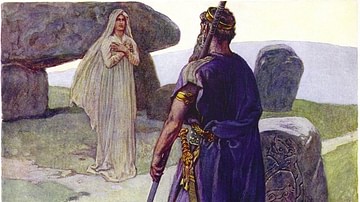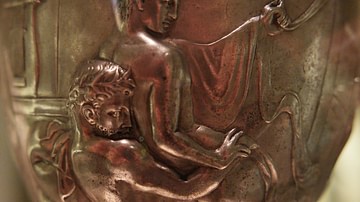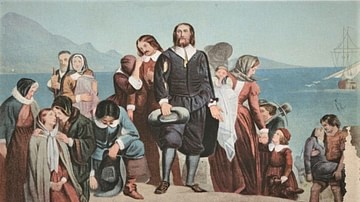Native American lore features many legendary creatures and supernatural entities that were understood as beneficial to humanity but just as many that posed serious threats to be avoided. These beings, although frightening, often served an important cultural function in warning the people away from danger or encouraging their appreciation of the power of the Spirit World.
Many Native Peoples of North America recognized multiple gods and spiritual entities who were either beneficial or detrimental to their welfare. A figure like Coyote, for example, could bring good or harm depending on his mood. Iktomi, the spider-trickster god of the Plains Indians Culture, served the same purpose, as did the trickster figures of other Native American Nations. The Great Mystery, or Great Spirit, known by many names, was understood to be in control of the operations of the universe and human life but, in answering “why do bad things happen to good people?” several far less pleasant entities were recognized as exerting considerable power. Among these were:
- Ogopogo
- Skin-Walker
- Wendigo
- Flying Head
- Two-Face
- Great Horned Serpent
- Katshituashku
- Bakwas
- Teihiihan
- Bigfoot
The forces of order and harmony, epitomized by the figure of the Thunderbird, were countered by those of chaos and disorder, as with Thunderbird’s underworld adversary, the Great Horned Serpent, according to Algonquian belief. Shamans – so-called “medicine men” or “medicine women” – who only sought the best for their people, were likewise countered by the figure of the Skin-Walker who had abandoned all principles to embrace the forces of darkness and deceit.
All of these creatures appear in tales which follow the basic form of the ghost story: a person or group of people encounter a supernatural entity and either overcome whatever dangers it presents or are overcome by them. Whether one was facing a Two-Face, a Flying Head, or a Bakwas, the essential form of the tale was the same.
The many different entities of Native American lore could fill several books and the following ten are only a very small sample. They serve to represent the much greater number, however, many of which share common features or purpose with some of the following.
Ogopogo
Ogopogo is a lake monster who first appears in the stories of the Secwepemc (Shuswap) and Syilx (Okanagan) First Nations of Canada in modern-day British Colombia. The creature is said to live in Okanagan Lake and is described as a large serpent with a dragon’s head. The Secwepemc and Syilx called the monster Naitaka – “water spirit” or “water demon” – while the origin of the name “Ogopogo” is disputed. The Ogopogo is said to demand tribute from anyone wishing to cross Okanagan Lake and, if nothing is offered, the person or people are drowned in a sudden storm whipped up by the creature. In the past, Native Americans would bring small animals to sacrifice to the lake before crossing and there are several legends concerning the unpleasant fate of those who refused to believe in Ogopogo and wound up drowning or narrowly escaping death. Like many other Native American creatures, Ogopogo served to remind the people of the power of nature and how it should be respected. Sightings of Ogopogo are still reported in the present day, as recently as 2018, with descriptions of the giant water snake matching those of the ancient legends.
Skin-Walker
The Skin-Walker is a shape-shifting witch of the Navajo who exists only to do harm to others. Skin-Walkers are understood to have once been shamans – people of significant spiritual power - who chose to use their gifts for evil instead of good. The simplest definition of a Skin-Walker, drawing on popular, non-Native culture, would be someone who embraces the “dark side” of the Force in the Star Wars franchise. Skin-Walkers can assume the shape of any animal or human they choose and might also possess someone in the same way an evil spirit, ghost, or demon was thought to do. The Navajo name for this entity translates as “by means of it, it goes on all fours” due to its penchant for taking the form of an animal. Whatever shape it chooses, its intent is never good and, as it is difficult to detect a Skin-Walker, they are understood as among the most dangerous Native American supernatural creatures.
Wendigo
The Wendigo is a voracious monster of the First Nations of Canada and Plains Indians culture who appears, under other names, in the stories of many Native American Nations across North America. According to the Chippewa, the Wendigo was once a human who could never be satisfied and was characterized by excessive selfishness and greed. Such people were thought to eventually become the human-eating monster with a heart of ice who preys upon people. The creature is depicted as an emaciated beast with large horns who is never satiated no matter how much it eats and so is doomed to wander about constantly trying and failing to satisfy its need for comfort. The Chippewa origin tale of the monster is echoed by other Nations and serves to reinforce the concept generally held by Native Americans that the needs of the community come before those of the individual. The Wendigo, as a selfish, ravenous, beast, stands as an antithesis to this central value.
Flying Head
The Flying Head (or Flying Heads) is similar to the Wendigo in that it is also an insatiable monster that feeds on human flesh. The creature originates in the legends of the Iroquois Nation who tell of a nameless tribe that once lived in the region of the USA now known as New York, around the Hudson River, whose conflict over an issue gave birth to the monster. According to the most popular version of the story, the region was struck with famine that drove the game, and even the fish, to other areas, and the younger members of the community suggested they follow suit. The elders refused, however, and insisted on remaining on their ancestral lands until the situation improved. The younger men grew tired of argument and murdered the elders, cutting off their heads and hurling them into a lake in a bundle but one of these young warriors became entangled in the ropes binding the heads and drowned. His life-energy combined with the severed heads to become the Flying Head (or, in some versions, Flying Heads) described as a giant head, sometimes with bat or bird wings on either side, and fangs. They swoop down, snatch people up, and devour them. Like the Wendigo, the Flying Head legend serves to support a central cultural value, in this case, that of respecting one’s elders and, of course, the prohibition against killing a member of one’s own tribe for selfish reasons, or any reason, outside of self-defense.
Two-Face
The Two-Face is a creature with one normal-looking face where it should be and another grotesque face on the back of its head. If one sees a Two-Face one either dies instantly or is frozen with fear and then killed by the monster using the razor-sharp talons protruding from its elbows. This monster is not to be confused with the two-faced entity known as Anpao of the Sioux who symbolizes the light of dawn. The Two-Face features in legends of the Cheyenne, Omaha, and Sioux (among others) and is best known from the legend of the Hero Twins in which a pregnant woman is murdered by a Two-Face who takes one of her unborn children with him and leaves the other. When the twins grow up, they find each other, avenge their mother, and become famous monster-slayers. The Two-Face is sometimes given as a single entity but, more often, as a race of ogre-like beings who periodically visit people just to kill them. The only way to avoid this fate is to not look directly at a stranger who comes to one’s home or avoid looking at them entirely and never to trust that the face one sees is the only face a stranger has.
Great Horned Serpent
The serpent, horned serpent, and water serpent figure is common to the legends of all Native American Nations in North America whether the Ogopogo or the Flathead Monster, the crystalline Uktena of the Cherokee, or the Great Horned Serpent of the Sioux and other Plains Indians Nations. Serpent Mound, the archaeological site in Peebles, Ohio, USA, attributed to the Native American cultures of the Adena or Fort Ancient, may be an homage to their own version of the horned serpent who always possessed magical properties and often, though not always, symbolized transformation. Serpents often serve as antagonists in Native American tales but are not always malevolent as they sometimes appear as challenges a hero must face in attaining a certain goal. The Great Horned Serpent, however, always appears as an adversary of the Thunderbird. As the Thunderbird represents order, light, birth, growth, and life, the Great Horned Serpent symbolizes chaos, darkness, and death.
Katshituashku
The Katshituashku is a gigantic stiff-legged, hairless, human-eating bear whose legend comes from the Penobscot Nation of the region of modern-day Maine, USA. The monster is described as immensely large with straight hind legs that cannot bend. It crashes through the forests walking upright and, as it can never lay down, since it cannot bend its knees to rise again, sleeps leaning against trees. As it is so large, it is often mistaken for a giant tree and overlooked until it swoops down with a gigantic paw and grabs its unsuspecting prey for a meal. Its name literally means “stiff-jointed bear”, but scholars do not agree on the origin of the creature or why the Penobscot would imagine such an entity. According to some theories, the Katshituashku was suggested to the Penobscot upon their discovery of a fossil of a Wooly Mammoth or Mastodon whose legs seemed to have been straight and skull to have resembled a bear’s. However it originated, its legend served as a reminder to be vigilant of one’s surroundings and possible dangers. Its stories were also told to children to scare them into staying close to home and not venturing alone into the woods.
Bakwas
The Bakwas (also given as Bukwus) is a ghost who tempts people lost in the woods into eating cursed food he presents to them in cockle shells and, if they accept, they become ghosts themselves. Ghosts, generally, are depicted in Native American lore as dangerous entities capable of causing physical, spiritual, or psychological harm to the living but the Bakwas was considered the “King of Ghosts” in that, while the spirit of a person who once lived might do the living a kindness if an agreement could be reached and the living showed proper respect, the Bakwas only had bad intentions. His legend originates with the First Nations of modern-day British Columbia, but his legend is similar to other entities of Nations to the north, like the Haida. He is depicted as a tall, skeletal man with long hair and in rags whose poor state encourages victims to pity him, making them vulnerable to his supposed kindness when he offers them food. He is sometimes associated with the ghosts of those who have drowned and haunts woodlands near water, thereby serving to scare children away from any unsupervised visits to the shore.
Teihiihan
The Teihiihan are the “little people” of the Arapaho Nation, a race of incredibly strong, mischievous, cannibalistic creatures, the size of children, possessed of superhuman speed. Although the name Teihiihan is Arapaho, the “little people” appear in the legends of many of the Plains Indians under other names. Generally, they are depicted as being between two and four feet in height with thick necks, large eyes, sharp teeth, and dark skin. They feed on humans and always kill more than they need, eating until they are satisfied and leaving the remains of the others to rot. According to some stories, they are able to make themselves invisible while, in others, they can fly and, in still others, they only seem to do either because of their incredible speed. Although the legends usually reference a long-ago conflict in which the Teihiihan were wiped out by a coalition led by the Arapaho, the “little people” are said to still exist today and are responsible for unsolved murders, the deaths of animals, and any items of value that go missing.
Bigfoot
The giant – and elusive – monster famously known as Bigfoot has its origins in Native American lore. The creature is always described as between six and ten feet tall and covered with hair. The Sioux know the entity as Chiye-Tanka – “Big Elder Brother” – but the same figure appears in stories of other Plains Indians Nations as well as First Nations of modern-day Canada and others of the east coast of the modern USA. According to some legends, the creatures have no spoken language but communicate with each other in grunts and whistles and are generally harmless unless threatened. They live deep in the woods, foraging for plants as their food by night, and are afraid of humans. Other legends, however, claim the creatures like to mate with female humans and may abduct them as well as small children who are then raised in the woods and are never seen again. They may also attack, kill, and eat people or play tricks on a village to encourage the people to make war on a neighboring community. Although the Bigfoot legends famously reported in media today only date from the early 20th century, the Native American stories regarding the same entity are most likely thousands of years old and were certainly being told before the first Europeans ever came to North America.
Conclusion
These stories maintain a concept common to all Native North American Nations of the “present past.” The past is never “past” but continues on in the present and will always continue in this same way. To cite only one example, in the story of the Teihiihan, it is given as a certainty that the “little people” were annihilated by the Arapaho and their allies in a great war, but these “little people” still exist in the present, as does the “great war” as long as the story continues to be told. Scholar Larry J. Zimmerman comments:
According to Native North American belief, beings such as culture heroes and tricksters lived in a sacred past that is not a remote, primordial period but a living, invisible parallel world that remains in being…Indians perceive the evidence of this “present past” in visions and dreams, and in the memories retained in oral tradition. The beings of this time often continue to make their presence felt in the physical world…[and] are kept alive through the spoken word. (202)
This is one of the reasons why storytelling is central to the culture of all Native North American Nations: the preservation of the past and keeping that past eternally “present.” The many frightening and menacing creatures of Native American lore were certainly not welcome entities, but they all served the purpose, in greater or lesser ways, of preserving the culture of the people, warning of the consequences of bad or careless behavior and, at the same time, of entertaining an audience through the kind of tales that were probably the first in the world ever told: the ghost story.









